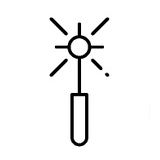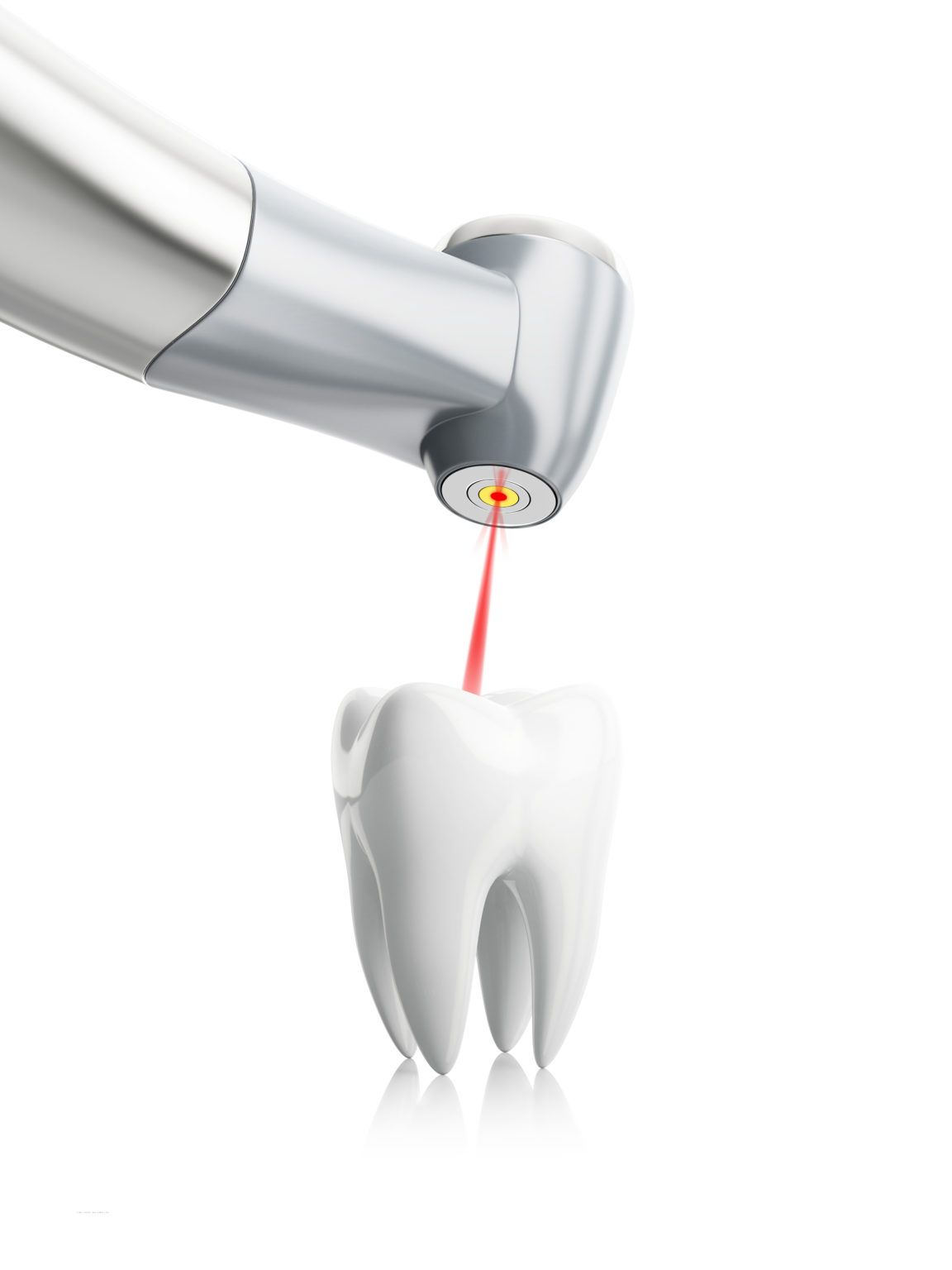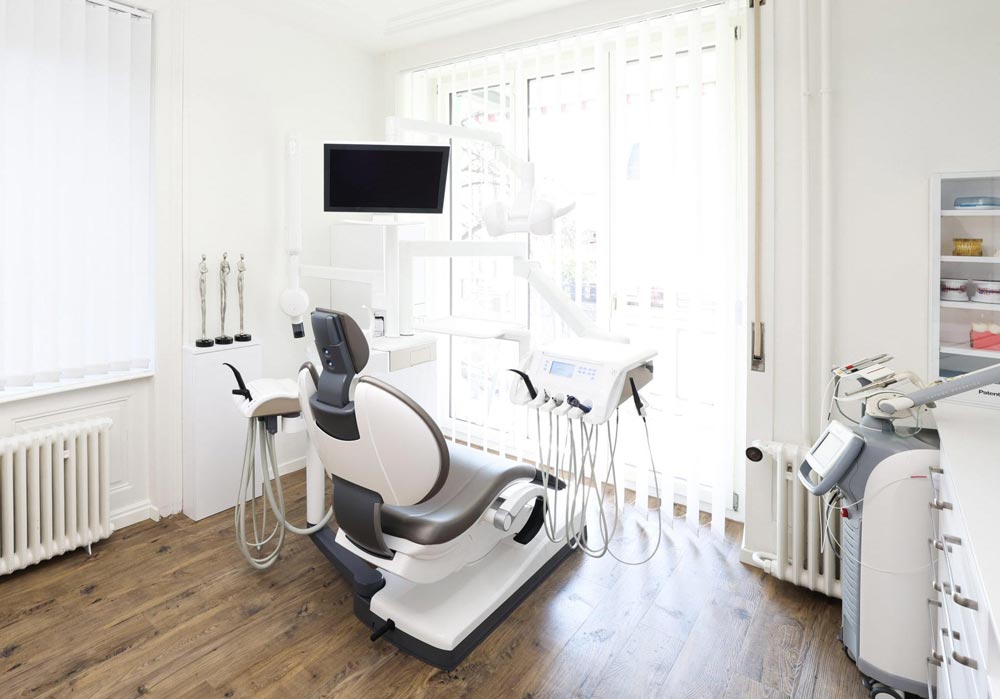Laser treatment
Laser instead of drilling
OUR PRICES:
- Emundo laser treatment (depending on teeth in need of treatment) = from 110 CHF
- NightLase treatment, 3 sessions (including consultation) = 1,500 CHF
MINIMALLY INVASIVE – LASER TREATMENT AT THE DENTIST
The laser enables drilling into the tooth without touching it, i.e. without the unpleasant vibration and heat generated by a drill. This means less to no pain for you when removing cavities. You can often even do without anesthesia and still remain mostly pain-free. Especially children and patients who suffer from so-called “dental fear” or fear of the drill can choose from the laser as a modern, gentle and painless treatment in modern dentistry. In addition, laser treatments remove caries very selectively from the tooth and leaves healthy tooth structure. As a result, in our dental office we can work with the laser much more gently than with the drill, which of course also benefits you.
YOUR BENEFITS

Caries treatment with the laser

Laser treatment for gums / periodontitis / herpes

Gentle, minimally invasive method

Faster healing

Also suitable for those with dental treatment fear

Flexible scheduling

PERIODONTOTIS / PERIODONTITIS – LASER TREATMENT FOR GUM INFLAMMATION
Sick tissue is removed in a gentle and painless manner. Periodontal pockets are cleaned and the further spread of germs through the blood is prevented. We then use the laser to clean and remodel both the pocket soft tissue and the damaged hard tissue. In addition to mechanical root cleaning, the tissue-preserving and bacteria-killing properties of the laser are a very effective weapon in the fight against gingivitis and diseases of the periodontium. In addition, we can use the laser to initiate regenerative biostimulation of the tissue after the actual treatment, which results in faster healing.
DESENSITIZE SENSITIVE TEETH WITH THE LASER
Many people suffer from sensitive tooth necks, and this can also be seen in the growing market for special toothpastes that are intended to provide quick relief. There are very good toothpastes, but they all need a certain amount of time for their active ingredients to develop a protective effect. Incidentally, the sensitivity comes from open dentin tubules, in which various thermal or chemical stimuli cause movement of the so-called dentin fluid. The nerve fibers are also moved, which causes the typical pain.
The neck of the tooth consists of root cement and is not covered by a protective layer of enamel like the rest of the tooth. It is sensitive and can even be “cleaned away” if you scrub too hard. Our dentist can use the laser to seal these dentin tubules so that fluid movement no longer occurs there. Laser treatment is painless and works immediately.


Frequently asked questions
What are the benefits of laser treatment at the dentist?
Laser treatment is an advanced method of dental care based on the use of laser beams. These beams will be precisely adjusted to treat only the desired areas, eliminating potentially more invasive drilling. Laser treatment at the dentist is also often perceived as more pleasant than traditional procedures. We primarily use a diode laser for the so-called Low Level Laser Therapy for a specific acceleration of wound healing, e.g. after tooth extractions or other oral surgical measures. The effect has been documented in many studies and is mainly based on improved ventilation of the cell by the mitochondria.
Is laser treatment at the dentist painful?
No, most patients report that laser treatments are less painful than conventional procedures. Sometimes local anesthesia is not even required and the treatment process is found to be more comfortable.
How safe is laser treatment at the dentist?
Laser treatments are generally very safe, provided of course that they are carried out by a qualified dentist like in our practice. Our dentist, Ms. Marinescu, has been working with lasers for many years and has a great deal of expertise. Lasers have the added benefit of causing less damage to surrounding tissue and improving the sterility of the treated area, reducing the risk of infection.
How long does the recovery time take after laser treatment?
In general, the recovery time after laser treatment is significantly shorter than with traditional surgical procedures. This is due to the less invasiveness and reduced damage to surrounding tissue.
Can every patient receive laser treatment?
While laser technology is widely used, there are certain requirements and contraindications. Our dentist will conduct a thorough evaluation to ensure this treatment is right for you.
How many sessions are required for laser treatment at the dentist?
That depends on the respective case. Some treatments, such as tartar removal, can be completed in one session. However, more complex procedures such as periodontitis treatment may require multiple sessions.
Can laser treatments stop bleeding gums?
Yes, laser treatments are particularly effective in controlling bleeding gums, which is often associated with gum disease. The laser beam seals the blood vessels, reducing bleeding and the associated symptoms.
Can I eat again immediately after laser treatment?
Sometimes it is better to wait a few hours or avoid certain foods so as not to disrupt the healing process. Our dentist will give you relevant information about this.
What about laser root canal treatment?
Despite high success rates, traditional root canal treatment has a crucial weakness, namely the insufficient penetration depth of the disinfectant rinsing solutions in the root canal system. Bacteria can survive for a long time after drilling and can cause the inflammation to flare up again years after a root canal treatment, as they can penetrate deeper into the tooth structure than can be seen from the outside. A latent inflammation (so-called “focus”) can put a strain on the immune system over a long period of time, even without the typical signs such as swelling and pain, because the body is constantly fighting an ongoing infection.
Laser-assisted root canal treatment has now been well studied and is very efficient. Both wavelengths are used here: the first (2940nm with the erbium laser) for extensive cleaning of the canal system. This is done by activating a rinsing solution that the dentist puts into the tooth. A special fiber causes a photoacoustic shock wave that transports the irrigation solution into the entire, often very complex canal system of the root. Tissue residues are completely removed from the root canal system. Before final closure, deep decontamination takes place with the Nd-YAG laser (the second wavelength). This has a destructive effect on the walls of the gram-negative bacteria that are in the canal system. The dentin tubules (tooth tubules) act like fine light guides for the laser beam, which can penetrate into the very deep layers of the tooth and comprehensively sterilize the root canal system.
How does laser treatment at the dentist help with herpes and canker sores?
Most people know them: as soon as you are a little stressed or you have eaten something wrong, they appear - the unpleasant sores! In some they are less pronounced and you can only see a small bubble on the lip, in others they extend partially to the nose. Laser treatment provides quick relief in all cases - even after the outbreak has occurred. The herpes sores are scabbed once without contact and the deep effect of the laser also kills the viruses.
Healing occurs twice as quickly as if left untreated and unpleasant accompanying symptoms such as oozing, itching and pain disappear completely.
However, the laser has the best effect BEFORE an outbreak, in the so-called prodromal phase, when it itches and “works” in the skin, but when nothing is visible yet. People who have experienced herpes recognize these signs early and can seek treatment in a timely manner. In these cases, there is usually no outbreak at all.
In both cases, however, healing occurs quickly and the herpes “attacks” even become less frequent or disappear completely.
Other pests are aphthous ulcers – recurring, very painful blisters on the oral mucosa. The treatment is the same (the two clinical pictures are very similar in manifestation). By the way, no anesthesia is necessary as the treatment does not cause any pain.






